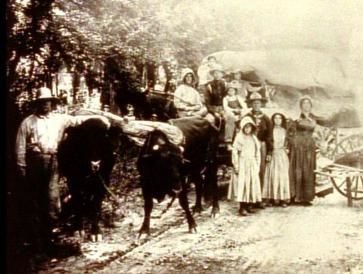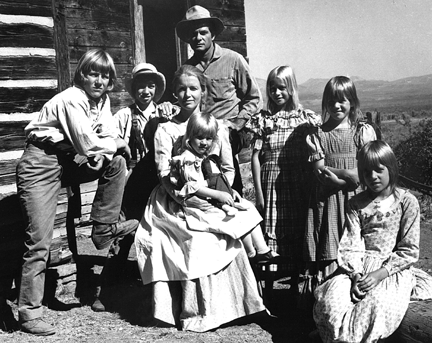
The Unvarnished Legend: The Sager Orphans and the Brutal Heart of the American Frontier
America, a land forged in ambition and hardship, teems with legends. From the towering lumberjack Paul Bunyan to the mythic figures of the Wild West, these stories often paint a romanticized picture of courage, ingenuity, and the triumph of the human spirit against insurmountable odds. But some legends aren’t spun from pure imagination; they are etched in blood and tears, born from real lives lived on the razor’s edge of the frontier. Among these, few tales resonate with such raw, unvarnished truth as that of the Sager orphans, a harrowing odyssey that encapsulates the brutal realities, the devastating losses, and the complex moral landscape of westward expansion. Their story is not merely a historical footnote; it is a profound American legend, a testament to resilience, and a chilling reminder of the price of Manifest Destiny.
In the spring of 1844, Henry and Naomi Sager, a young couple with a burgeoning family, answered the siren call of the Oregon Country. Like thousands before and after them, they envisioned a new life, a prosperous future on the fertile lands of the Pacific Northwest. Leaving behind their home in Missouri, they joined a wagon train, seven children in tow: the eldest, Catherine, just thirteen; Elizabeth, eleven; Matilda, nine; John, seven; Henrietta, five; and the two youngest, twins Francisco and Amanda, barely toddlers. Their journey, a 2,000-mile odyssey across prairies, mountains, and deserts, was an act of audacious faith, a gamble against nature, disease, and the unknown.
The Oregon Trail was not merely a path; it was a crucible. Dust, hunger, thirst, and the constant threat of accident were daily companions. Disease, however, was the most insidious enemy. Typhoid, cholera, and measles swept through wagon trains, claiming lives with ruthless efficiency. The Sagers were not spared. In August, while navigating the treacherous terrain near the Snake River, tragedy struck. Henry Sager, attempting to retrieve a rope from under a moving wagon, was crushed. Though he lingered for a few agonizing days, infection set in, and he died, leaving Naomi, heavily pregnant, to bury her husband in a hastily dug grave on the vast, indifferent prairie.

Naomi, a woman of immense fortitude, pushed on, but the physical and emotional toll was unbearable. Just weeks later, having given birth to a daughter, whom she named after her deceased husband, Elizabeth, she too succumbed to the ravages of "camp fever," likely a form of typhoid. Her last wish, whispered to her children and the few sympathetic souls in the wagon train, was that her children find a good home, that they be kept together. Now, just weeks after their father, the Sager children – eight of them, ranging from a newborn to a bewildered teenager – were orphans, adrift in a sea of strangers, hundreds of miles from their destination.
This is where the legend truly begins to take shape, where the stark reality of the frontier’s “kindness of strangers” comes into play. A sympathetic doctor, Marcus Whitman, traveling with his own family to his mission in the Walla Walla Valley, heard of the Sager children’s plight. A man of deep religious conviction and a pioneer spirit, Whitman offered to take the children to his Waiilatpu Mission. And so, the Sager orphans, a symbol of the trail’s relentless cruelty, arrived at what they hoped would be their sanctuary.
The Whitman Mission, established in 1836 by Marcus and his wife Narcissa, was more than a spiritual outpost; it was a critical way station for emigrants on the Oregon Trail, a place offering respite, supplies, and medical care. For the Sager children, it represented a new, albeit difficult, chapter. Narcissa Whitman, though herself a grieving mother who had lost her own child years earlier, struggled to cope with the influx of children, especially the boisterous Sagers. The older girls, particularly Catherine, were expected to take on significant domestic duties, helping to care for the younger children and contribute to the mission’s arduous daily routine.
Life at Waiilatpu was a delicate balance, a microcosm of the larger clash between cultures that defined the frontier. The Whitmans’ primary mission was to convert the local Cayuse people to Christianity and to introduce them to agricultural practices. However, this well-intentioned effort was fraught with misunderstanding and resentment. The Cayuse, a proud and independent people, watched as more and more American settlers encroached on their ancestral lands, brought diseases for which they had no immunity, and seemed to disregard their customs and sovereignty.
“The Cayuse felt the land was theirs, given by the Great Spirit,” historian Robert Utley noted in his work on the frontier, “and the Americans were intruders, not guests.” This sentiment, simmering beneath the surface for years, was exacerbated by the devastating epidemics that routinely swept through Native American communities following contact with settlers. The Cayuse observed that while white settlers often recovered from diseases like measles, their own people, particularly their children, died in staggering numbers. Marcus Whitman, as a doctor, found himself in an impossible situation: his medical efforts were often perceived as ineffective, or worse, as intentional poisoning, by a people desperate for an explanation for their suffering.
The winter of 1847 brought a particularly virulent strain of measles to Waiilatpu. It ravaged the mission, striking down both settlers and Cayuse. While many white children, including the Sagers, recovered, the Cayuse children perished at an alarming rate. The cultural chasm between the two groups yawned into an abyss of mistrust. In Cayuse tradition, a failed shaman, one whose healing powers were ineffective, was often put to death. In their grief and desperation, some Cayuse leaders, interpreting Whitman’s failures through their own cultural lens, saw him not as a healer, but as a malevolent sorcerer.
On November 29, 1847, the simmering tensions exploded into unspeakable violence. A group of Cayuse warriors, driven by grief, fear, and a distorted sense of justice, attacked the mission. Marcus Whitman was struck down first, followed by Narcissa and twelve others. It was a massacre, a brutal act of desperation and vengeance that would forever scar the American consciousness.
The Sager children were caught in the inferno. Catherine, Elizabeth, Matilda, John, Henrietta, and Francisco, along with 47 other women and children, were taken captive by the Cayuse. Little Amanda, the newborn, had died shortly before the massacre. For nearly a month, they endured the terror of captivity, unsure of their fate, witnessing further acts of violence and degradation. Catherine, the eldest, bravely tried to protect her younger siblings, clinging to the hope of rescue.

Their ordeal finally ended through the intervention of Peter Skene Ogden, a prominent figure of the Hudson’s Bay Company. Recognizing the catastrophic potential of further conflict, Ogden negotiated with the Cayuse, trading blankets, tobacco, and muskets for the release of the captives. In late December, the Sager children, traumatized but alive, were finally freed, embarking on another arduous journey to Fort Vancouver.
The aftermath of the Whitman Massacre sent shockwaves across the nation, fueling anti-Native American sentiment and accelerating the push for military intervention in the Oregon Territory. For the Sager children, however, the rescue was not an end to their suffering, but the beginning of another long, difficult chapter. Dispersed among various families in the burgeoning Oregon settlements, they were separated, their bond as a family shattered.
Their lives unfolded with varying degrees of success and hardship. Catherine, the resilient eldest, married Clark Pringle and eventually became a revered chronicler of their harrowing journey. Her memoirs, written decades later, provided invaluable first-hand accounts of the Oregon Trail, the mission, and the massacre. She wrote with a plainspoken honesty, her words carrying the weight of experience: "We children were like sheep without a shepherd. There was no one to guide us, no one to comfort us." Her narrative is not just a personal story; it is a foundational text of American frontier history.
Elizabeth, too, found a husband and raised a family, though her life was marked by the lingering trauma of her youth. Matilda married and eventually moved to California. John, the only surviving boy, drifted for years, his spirit perhaps too broken by the horrors he had witnessed. Henrietta and Francisco also survived into adulthood, but their stories are less documented, fading into the broader narrative of frontier lives. Louisa, the sister born on the trail, died shortly after their rescue, unable to recover from the rigors of her early life.
The Sager orphans’ tale is not merely a grim chapter in American history; it is a potent legend, one that speaks to the core of the nation’s identity. It embodies the relentless optimism that drove pioneers westward, the incredible human capacity for endurance in the face of unimaginable loss, and the tragic consequences of cultural collision. Their story became a touchstone for the "Oregon Fever" generation, a stark reminder of the sacrifices demanded by the frontier.
In an era when the narrative of Manifest Destiny often glossed over the human cost, the Sager orphans served as a tangible, heartbreaking illustration of the price paid. They are a legend of innocence lost, of childhoods irrevocably altered, and of the enduring scars left by a nation in the throes of expansion. Their story compels us to look beyond the romanticized legends of heroism and success, to acknowledge the brutal realities, the moral complexities, and the profound sorrow that also shaped the American West. It reminds us that behind every grand historical movement are countless individual human stories, some of which, like that of the Sager orphans, are so powerful, so poignant, that they transcend mere history and become an enduring, unvarnished legend.


